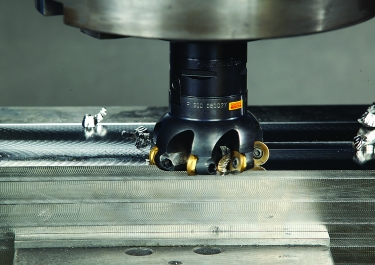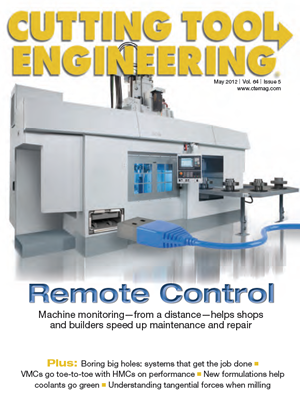 Author Edmund Isakov, Ph.D.
Author Edmund Isakov, Ph.D.

Image courtesy of Sandvik Coromat
[Editor’s Note: This article was written in response to request by Matt Cawyer at Four State Industrial Supply Co. Inc., Carthage, Mo., who wrote the author seeking a formula to determine the torque required by a cutting tool when milling the titanium alloy Ti6Al4V.]
The tangential cutting force, if end users know how to determine it, and the cutting speed, which is selected as one of several machining parameters, allow calculating the required machining power for an operation. When the required machining power value is about the same as the milling machine’s rated power, milling productivity approaches its maximum.
Torque (Ts) that is applied to the spindle, and therefore to the milling cutter, is generated by the tangential cutting force (Ft) and can be calculated by the formula:
Ts = Ft × R (1)
Where R is a radius of a milling cutter. (Formulas are referenced later by the number in parentheses.)
Torque (Ts) Calculator
Torque (Ts):
Formula: Ts = Ft × R
The concept of calculating tangential cutting force when milling is based on the author’s analytical study of metalcutting principles and experimental study of milling cutters with positive-negative and double-positive geometries.
This concept is based on relationships between the following parameters:
- Ultimate tensile strength (σ) of metallic work materials vs. their hardness,
- Cross-sectional area of the uncut chip (A),
- Number of teeth engaged with a workpiece (Zc),
- Engagement factor of a workpiece material (Ef), and
- Cutting tool wear factor (Tf).
The following tangential cutting force formula was developed in accordance with these relationships:
Ft = σ × A × Zc × Ef × Tf (2)
Tangential Cutting Force (Ft) Calculator
Tangential Cutting Force (Ft):
Formula: Ft = σ × A × Zc × Ef × Tf
Because of the end user’s interest in milling a specific titanium alloy, the following information is provided about Ti6Al4V, an alpha-beta titanium alloy. It is used for making aircraft gas turbine discs and blades, airframe structural components and other applications requiring high strength at temperatures up to 600° F (315° C).
The ultimate tensile strength of Ti6Al4V at its annealed condition is 137,000 psi (945 MPa in the metric system), having a hardness of 36 HRC.
The shape of the uncut chip’s cross section depends on the cutting insert geometry and the milling cutter’s lead angle. Square, hexagonal or octagonal inserts have straight cutting edges and produce chips with a rectangular cross section when the milling cutter has a 0° lead angle or a parallelogram cross section when the milling cutter has a lead angle greater than 0°.
The following formula is recommended for calculating the cross-sectional area of the uncut chip:
A = ap × f (3)
Where ap is the axial DOC and f is the feed per tooth, or chip load.
The number of teeth engaged with a workpiece (Zc) depends on the number of teeth in the cutter (Z) and the engagement angle (α). The formula for calculating Zc is:
Zc = Z × α ÷ 360° (4)
The engagement angle depends on the radial WOC (W). If the radial WOC equals the milling cutter diameter (D), the engagement angle has a maximum value of 180°, and the number of engaged teeth is half the number of teeth in the cutter:
Zc = Z × 180° ÷ 360º = 0.5 Z (5)
If the engagement angle is less than 180°, it is calculated by formulas containing trigonometric functions. Detailed description of these formulas and supporting illustrations were published in the July 2010 issue of CTE (see “New Mill” by E. Isakov, p. 44).
Engagement Factors
The engagement factor of a workpiece material (Ef) is a dimensionless coefficient included in formula (2) to correlate tangential cutting force with the ratio of the radial WOC to the cutter diameter (W ÷ D).
Milling is more effective when sufficiently thick and uniform chips are produced. The W/D ratio affects uniformity of the chip thickness. When the radial WOC equals the cutter diameter (W ÷ D = 1), the chip being formed starts at zero thickness at the point of entry. It then increases to a maximum thickness at the centerline of the cutter and thins to zero at the point of exit. This type of cut produces a nonuniform chip, generates maximum friction at the cutting edge and, as a result, increases the chip’s resistance to being cut. Effective milling is obtained when the radial WOC is about two-thirds of the cutter diameter. Such a cut produces uniform and sufficiently thick chips, generates less friction at the cutting edge and decreases cutting resistance.
Cutting Tool Wear Factors
The cutting tool wear factor (Tf) is a dimensionless coefficient included in formula (2) to correlate tangential cutting force with increasing wear of the cutting inserts when milling. When applying new or just indexed cutting inserts for a short time (20 to 25 percent of tool life), the cutting tool wear factor (Tf) is 1.0; when milling until the inserts must be indexed or replaced (100 percent of tool life), the following cutting tool wear factors are recommended according to the type of operation (Machinery’s Handbook, 29th Edition, p. 1,086).

Table. Responses from metalworking professionals describing milling operations by optimal ranges of axial DOC and feed per tooth.
- Light and medium facemilling: 1.10 to 1.25
- Extra-heavy-duty facemilling: 1.30 to 1.60
Unfortunately, the publications reviewed by the author do not have data that could identify each milling operation. Therefore, the author prepared a questionnaire requesting machining data that would best describe the milling operations by optimal ranges of axial DOC and feed per tooth. The questionnaire was sent to more than 100 industrial professionals with practical knowledge and experience in milling applications and more than 80 percent responded. Statistical treatment of their responses produced the data shown in the table above.
Machining Power
Having calculated tangential cutting (Ft), the machining power requirement at the spindle (Ps) and main drive (Pm) can be calculated by the following formulas.
Customary U.S. units of measurement:
Power at spindle: Ps = Ft × Vc ÷ 33,000 (hp) (6)
Power at main drive: Pm = Ps ÷ E (hp) (7)
Where Ft is expressed in pounds, Vc is the cutting speed in sfm, 33,000 is a factor converting ft.-lbs. per minute into horsepower, and E is a main drive efficiency factor expressed as a percentage.
Metric units of measurement:
Power at spindle: Ps = Ft × Vc ÷ 60,000 (kW) (8)
Power at main drive: Pm = Ps ÷ E (kW) (9)
Where Ft is in newtons, Vc is the cutting speed expressed in m/min., 60,000 is a factor converting newton × m/min. into kilowatts, and E is a main drive efficiency factor expressed as a percentage.
Power at Spindle (Ps) Calculator
Power at Spindle (Ps):
Formula: Ps = Ft × Vc ÷ 33,000 (in hp)
Main Drive Power (Pm) Calculator
Power at Main Drive (Pm):
Formula: Pm = Ps ÷ E
Calculations
Results of calculating tangential cutting force, torque and machining power values when milling Ti6Al4V are based on the selected facemill’s geometry and machining parameters submitted by the end user.
Facemill
Catalog item: SOF 8/16-D2.0
Diameter: 2.0 " (50.8mm)
Lead angle: 44°
Number of indexable inserts: six
Insert’s catalog item: ONHU 0505 (octagonal double-sided inserts)
Machining parameters
Axial DOC: 0.100 " (2.54mm)
Radial WOC: 2.0 " (50.8mm)
Feed per tooth: 0.006 " (0.15mm)
Cutting speed: 180 sfm (55 m/min.)
Machine efficiency factor: 90 percent, or 0.9
The author performed the calculations using his Advanced Milling Calculators (one for U.S. units and another for metric units).
Tangential cutting force, formula (2)
The formula contains five elements with the following values:
1. Ultimate tensile strength, σ = 137,000 psi (945 MPa)
2. Cross-sectional area of the uncut chip, A = 0.1 × 0.006 = 0.0006 in.2 (0.381 mm2)
3. Number of teeth engaged with the workpiece, Zc = 6 × 180° ÷ 360° = 3 (full engagement)
4. Engagement factor, Ef = 1.7 (for the titanium alloy workpiece at full engagement)
5. Cutting tool wear factor, Tf = 1.1 (represents “light milling,” see Table)
Tangential cutting force (customary U.S. units of measurement):
Ft = 137,000 × 0.0006 × 3 × 1.7 = 419.2 lbs. (new or just indexed inserts)
Ft = 137,000 × 0.0006 × 3 × 1.7 × 1.1 = 461.1 lbs. (indexing of inserts is required)
Tangential cutting force (metric units of measurement):
Ft = 945 × 0.381 × 3 × 1.7 = 1,836.2 N (new or just indexed inserts)
Ft = 945 × 0.381 × 3 × 1.7 × 1.1 = 2,019.8 N (indexing of inserts is required)
Torque at the spindle (cutter), formula (1)
U.S. units:
Ts = Ft × R = 419.2 × 1 = 419.2 in.-lbs. = 34.9 ft.-lbs. (new or just indexed inserts)
Ts = Ft × R = 461.1 × 1 = 461.1 in.-lbs. = 38.4 ft.-lbs. (indexing of inserts is required)
Metric units:
Ts = Ft × R = 1,836.2 × 0.0254 = 46.6 Nm (new or just indexed inserts)
Ts = Ft × R = 2,019.8 × 0.0254 = 51.3 Nm (indexing of inserts is required)
Machining power requirement at the spindle:
U.S. units, formula (6)
Ps = 419.2 × 180 ÷ 33,000 = 2.29 hp (new or just indexed inserts)
Ps = 461.1 × 180 ÷ 33,000 = 2.52 hp (indexing of inserts is required)
Machining power requirement at the main drive:
U.S. units, formula (7)
Pm = 2.29 ÷ 0.9 = 2.54 hp (new or just indexed inserts)
Pm = 2.52 ÷ 0.9 = 2.80 hp (indexing of inserts is required)
Machining power requirement at the spindle:
Metric units, formula (8)
Ps = 1,836.2 × 55 ÷ 60,000 = 1.68 kW (new or just indexed inserts)
Ps = 2,019.8 × 55 ÷ 60,000 = 1.85 kW (indexing of inserts is required)
Machining power requirement at the main drive:
Metric units, formula (9)
Pm = 1.68 ÷ 0.9 = 1.87 kW (new or just indexed inserts)
Pm = 1.85 ÷ 0.9 = 2.06 kW (indexing of inserts is required)
Formulas for calculating cutting force when milling are described in various technical papers and books. Some formulas are extremely complex, consisting of two matrices and eight trigonometric equations. Another example, the cutting force formula, is a second-order differential equation:

Where (M) is the mass matrix of the cutting system, (C) is the damping matrix of the cutting system, and (K) is the stiffness matrix of the cutting system. Two dots above X mean it is the second derivative of X; one dot above X is the first derivative of X. X is a complex function, containing six variables: X = (x1 x2y1 y2 z1 z2)T. Unfortunately, definitions of x, y, z and T were not provided.
Such complex formulas are not useful in practical engineering calculations because only mathematicians who are proficient in calculus can execute them. Therefore, simple engineering formulas, such as those presented in this article, are recommended. They provide, at least, 85 percent accuracy.
When milling Ti6Al4V, understanding the tangential cutting force and being able to calculate the required machining power are the first steps to maximizing productivity.
Related Glossary Terms
- cutting force
cutting force
Engagement of a tool’s cutting edge with a workpiece generates a cutting force. Such a cutting force combines tangential, feed and radial forces, which can be measured by a dynamometer. Of the three cutting force components, tangential force is the greatest. Tangential force generates torque and accounts for more than 95 percent of the machining power. See dynamometer.
- cutting speed
cutting speed
Tangential velocity on the surface of the tool or workpiece at the cutting interface. The formula for cutting speed (sfm) is tool diameter 5 0.26 5 spindle speed (rpm). The formula for feed per tooth (fpt) is table feed (ipm)/number of flutes/spindle speed (rpm). The formula for spindle speed (rpm) is cutting speed (sfm) 5 3.82/tool diameter. The formula for table feed (ipm) is feed per tooth (ftp) 5 number of tool flutes 5 spindle speed (rpm).
- facemill
facemill
Milling cutter for cutting flat surfaces.
- feed
feed
Rate of change of position of the tool as a whole, relative to the workpiece while cutting.
- gang cutting ( milling)
gang cutting ( milling)
Machining with several cutters mounted on a single arbor, generally for simultaneous cutting.
- hardness
hardness
Hardness is a measure of the resistance of a material to surface indentation or abrasion. There is no absolute scale for hardness. In order to express hardness quantitatively, each type of test has its own scale, which defines hardness. Indentation hardness obtained through static methods is measured by Brinell, Rockwell, Vickers and Knoop tests. Hardness without indentation is measured by a dynamic method, known as the Scleroscope test.
- lead angle
lead angle
Angle between the side-cutting edge and the projected side of the tool shank or holder, which leads the cutting tool into the workpiece.
- metalcutting ( material cutting)
metalcutting ( material cutting)
Any machining process used to part metal or other material or give a workpiece a new configuration. Conventionally applies to machining operations in which a cutting tool mechanically removes material in the form of chips; applies to any process in which metal or material is removed to create new shapes. See metalforming.
- metalworking
metalworking
Any manufacturing process in which metal is processed or machined such that the workpiece is given a new shape. Broadly defined, the term includes processes such as design and layout, heat-treating, material handling and inspection.
- milling
milling
Machining operation in which metal or other material is removed by applying power to a rotating cutter. In vertical milling, the cutting tool is mounted vertically on the spindle. In horizontal milling, the cutting tool is mounted horizontally, either directly on the spindle or on an arbor. Horizontal milling is further broken down into conventional milling, where the cutter rotates opposite the direction of feed, or “up” into the workpiece; and climb milling, where the cutter rotates in the direction of feed, or “down” into the workpiece. Milling operations include plane or surface milling, endmilling, facemilling, angle milling, form milling and profiling.
- milling cutter
milling cutter
Loosely, any milling tool. Horizontal cutters take the form of plain milling cutters, plain spiral-tooth cutters, helical cutters, side-milling cutters, staggered-tooth side-milling cutters, facemilling cutters, angular cutters, double-angle cutters, convex and concave form-milling cutters, straddle-sprocket cutters, spur-gear cutters, corner-rounding cutters and slitting saws. Vertical cutters use shank-mounted cutting tools, including endmills, T-slot cutters, Woodruff keyseat cutters and dovetail cutters; these may also be used on horizontal mills. See milling.
- milling machine ( mill)
milling machine ( mill)
Runs endmills and arbor-mounted milling cutters. Features include a head with a spindle that drives the cutters; a column, knee and table that provide motion in the three Cartesian axes; and a base that supports the components and houses the cutting-fluid pump and reservoir. The work is mounted on the table and fed into the rotating cutter or endmill to accomplish the milling steps; vertical milling machines also feed endmills into the work by means of a spindle-mounted quill. Models range from small manual machines to big bed-type and duplex mills. All take one of three basic forms: vertical, horizontal or convertible horizontal/vertical. Vertical machines may be knee-type (the table is mounted on a knee that can be elevated) or bed-type (the table is securely supported and only moves horizontally). In general, horizontal machines are bigger and more powerful, while vertical machines are lighter but more versatile and easier to set up and operate.
- stiffness
stiffness
1. Ability of a material or part to resist elastic deflection. 2. The rate of stress with respect to strain; the greater the stress required to produce a given strain, the stiffer the material is said to be. See dynamic stiffness; static stiffness.
- tensile strength
tensile strength
In tensile testing, the ratio of maximum load to original cross-sectional area. Also called ultimate strength. Compare with yield strength.



